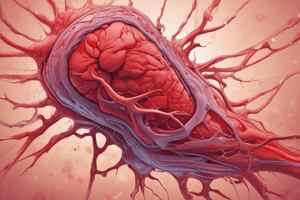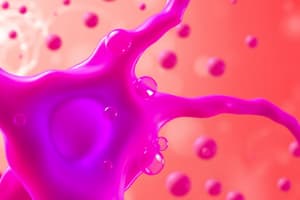Podcast
Questions and Answers
In the intricate dance of hemostasis, what is the quintessential role of secondary hemostasis?
In the intricate dance of hemostasis, what is the quintessential role of secondary hemostasis?
- To engender a catalytic surface upon which the tenase and prothrombinase complexes assemble to amplify thrombin generation.
- To instigate the extrinsic cascade via the cellular expression of tissue factor, thus obviating the necessity for contact activation.
- To facilitate the transient aggregation of platelets, thereby initiating the preliminary blockade of vascular lesions.
- To orchestrate the synthesis of a robust and insoluble fibrin mesh, effectively fortifying the delicate platelet plug (correct)
Within the labyrinthine coagulation cascade, how does Factor XIII (fibrin-stabilizing factor) fulfill its indispensable function?
Within the labyrinthine coagulation cascade, how does Factor XIII (fibrin-stabilizing factor) fulfill its indispensable function?
- Initiates the intrinsic pathway through the activation of Factor XII (Hageman factor).
- Acts as a cofactor to accelerate the activation of Factor X by Factor IXa.
- Converts prothrombin to thrombin through the cleavage of peptide bonds.
- Catalyzes the formation of covalent cross-links between fibrin monomers, thereby stabilizing the fibrin clot. (correct)
Considering the paramount importance of Vitamin K in coagulation, elucidate its precise mechanism of action.
Considering the paramount importance of Vitamin K in coagulation, elucidate its precise mechanism of action.
- Serving as a cofactor for gamma-glutamyl carboxylase, which catalyzes the post-translational modification of specific glutamic acid residues on certain coagulation factors. (correct)
- Facilitating the polymerization of fibrin monomers into insoluble fibrin polymers.
- Enhancing the activity of antithrombin III, thereby accelerating the inactivation of thrombin and other serine proteases.
- Directly inhibiting the synthesis of prothrombin in hepatocytes, thus preventing excessive thrombin generation.
Delving into the intricacies of coagulation regulation, how does the thrombomodulin-protein C pathway serve to dampen exuberant thrombin generation?
Delving into the intricacies of coagulation regulation, how does the thrombomodulin-protein C pathway serve to dampen exuberant thrombin generation?
How does Tissue Factor Pathway Inhibitor (TFPI) exert its inhibitory effects on the coagulation cascade?
How does Tissue Factor Pathway Inhibitor (TFPI) exert its inhibitory effects on the coagulation cascade?
In the context of contact activation, how does Prekallikrein contribute to the intricacies of coagulation and inflammation?
In the context of contact activation, how does Prekallikrein contribute to the intricacies of coagulation and inflammation?
What is the singular enzymatic function of a transamidase in the context of the coagulation cascade?
What is the singular enzymatic function of a transamidase in the context of the coagulation cascade?
Considering the multifarious roles of thrombin, how does it participate in both procoagulant and anticoagulant processes?
Considering the multifarious roles of thrombin, how does it participate in both procoagulant and anticoagulant processes?
Within the context of fibrinolysis, what role does Thrombin-activatable Fibrinolysis Inhibitor (TAFI) play?
Within the context of fibrinolysis, what role does Thrombin-activatable Fibrinolysis Inhibitor (TAFI) play?
How does the activation of the kinin system contribute to the intricate interplay between coagulation, inflammation, and blood pressure regulation?
How does the activation of the kinin system contribute to the intricate interplay between coagulation, inflammation, and blood pressure regulation?
In considering the mechanisms of action of therapeutic anticoagulants, how does heparin augment the function of antithrombin III (ATIII)?
In considering the mechanisms of action of therapeutic anticoagulants, how does heparin augment the function of antithrombin III (ATIII)?
What is the principal rationale for distinguishing between single-chain urokinase plasminogen activator (scuPA) and two-chain urokinase plasminogen activator (tcuPA)?
What is the principal rationale for distinguishing between single-chain urokinase plasminogen activator (scuPA) and two-chain urokinase plasminogen activator (tcuPA)?
In the context of coagulation testing, what critical insight does the D-dimer assay provide concerning hemostatic and fibrinolytic activity?
In the context of coagulation testing, what critical insight does the D-dimer assay provide concerning hemostatic and fibrinolytic activity?
Why are patients with deficiencies in the contact factors (Factor XII, Prekallikrein, High Molecular Weight Kininogen) often asymptomatic, despite abnormal in vitro coagulation tests?
Why are patients with deficiencies in the contact factors (Factor XII, Prekallikrein, High Molecular Weight Kininogen) often asymptomatic, despite abnormal in vitro coagulation tests?
How does the phospholipid surface of platelets contribute to the amplification of the coagulation cascade?
How does the phospholipid surface of platelets contribute to the amplification of the coagulation cascade?
How does von Willebrand factor (vWF) contribute to both primary and secondary hemostasis?
How does von Willebrand factor (vWF) contribute to both primary and secondary hemostasis?
What is the crucial role of calcium ions (Ca++) in the coagulation cascade?
What is the crucial role of calcium ions (Ca++) in the coagulation cascade?
How does the Glycoprotein IIb/IIIa receptor contribute to hemostasis?
How does the Glycoprotein IIb/IIIa receptor contribute to hemostasis?
Compared to the Intrinsic pathway, why is the Extrinsic pathway more emphasized as the dominant pathway in vivo?
Compared to the Intrinsic pathway, why is the Extrinsic pathway more emphasized as the dominant pathway in vivo?
Flashcards
Secondary Hemostasis
Secondary Hemostasis
The coagulation of plasma; also called the fibrin-forming coagulation system.
Coagulation
Coagulation
The process where blood forms clots, involving plasma proteins, tissue factors, and calcium interaction on platelet surfaces to form a fibrin clot.
Fibrinogen
Fibrinogen
Factor I; the precursor protein that thrombin acts on during coagulation.
Prothrombin
Prothrombin
Signup and view all the flashcards
Tissue Factor
Tissue Factor
Signup and view all the flashcards
Calcium
Calcium
Signup and view all the flashcards
Proaccelerin (Factor Va)
Proaccelerin (Factor Va)
Signup and view all the flashcards
Proconvertin
Proconvertin
Signup and view all the flashcards
Antihemophilic Factor (AHF)
Antihemophilic Factor (AHF)
Signup and view all the flashcards
Plasma Thromboplastin Component (PTC)
Plasma Thromboplastin Component (PTC)
Signup and view all the flashcards
Stuart-Prower Factor
Stuart-Prower Factor
Signup and view all the flashcards
Plasma Thromboplastin Antecedent
Plasma Thromboplastin Antecedent
Signup and view all the flashcards
Hageman Factor
Hageman Factor
Signup and view all the flashcards
Fibrin Stabilizing Factor
Fibrin Stabilizing Factor
Signup and view all the flashcards
Prekallikrein
Prekallikrein
Signup and view all the flashcards
Zymogen
Zymogen
Signup and view all the flashcards
Cofactors
Cofactors
Signup and view all the flashcards
Substrate
Substrate
Signup and view all the flashcards
Role of Vitamin K
Role of Vitamin K
Signup and view all the flashcards
The coagulation cascade
The coagulation cascade
Signup and view all the flashcards
Study Notes
Secondary Hemostasis
- Involves plasma coagulation
- Functions as a fibrin-forming coagulation system
- Produces a stable fibrin clot, strengthening the platelet plug
- Follows cascading reactions involving coagulation factors
- Generates thrombin to convert fibrinogen to fibrin
Coagulation
- Process where blood forms clots
- Occurs when plasma proteins, tissue factors, and calcium interact on platelets after vessel injury to form a fibrin clot
- Plays a role in the immune system
Coagulation Factor Nomenclature
- Fibrinogen: Factor I
- Prothrombin: Factor II
- Tissue Factor: Factor III
- Calcium: Factor IV
- Proaccelerin: Factor V
- Factor VI does not exist
- Proconvertin: Factor VII
- Antihemophilic Factor (AHF): Factor VIII
- Plasma Thromboplastin Component (PTC): Factor IX
- Stuart-Prower Factor: Factor X
- Plasma Thromboplastin Antecedent: Factor XI
- Hageman Factor: Factor XII
- Fibrin Stabilizing Factor: Factor XIII
- Prekallikrein: Fletcher Factor
- High-Molecular Weight Kininogen (HMWK): Fitzgerald Factor
Coagulation Factors
- Numbered by discovery date
- Each factor has one or more names
- Nomenclature is standardized by the International Committee on Nomenclature of Blood Clotting Factors (1958)
- Roman numerals are used
Characteristics of Procoagulants
- Fibrinogen is the only substrate that doesn't become an activated enzyme during the cascade
- Fibrinogen is the primary substrate for making fibrin; thrombin prefers fibrinogen
- Factors, Minimum Hemostatic Level (%), Mean Plasma Concentration (mg/dL), and In-Vivo Half-Life (hours)
- Factor I: 100%, 200-400 mg/dL, 100-150 hours
- Factor II: 20-40%, 10 mg/dL, 60 hours
- Factor V: 10-25%, 1 mg/dL, 24 hours
- Factor VII: 5-10%, 0.05 mg/dL, 6 hours
- Factor VIII: 25-30%, 0.01 mg/dL, 12 hours
- Factor IX: 15-25%, 0.3 mg/dL, 24 hours
- Factor X: 10-20%, 1 mg/dL, 48-52 hours
- Factor XI: 10-20%, 0.5 mg/dL, 48-84 hours
- Factor XII: 0-5%, 3 mg/dL, 48-70 hours
- Factor XIII: 2-3%, 2 mg/dL, 150 hours
- Prekallikrein: 35-50 ug/L, 35 hours
- HMWK: 5 ug/L, 156 hours
Kinin System
- Includes Prekallikrein, Kallikrein, Kininogen (LMWK and HMWK), and Kinins (bradykinins)
- Activated by coagulation and fibrinolytic systems
- The action of the system increases vascular permeability, vasodilation, hypotension, and contraction of smooth muscle
Coagulation Factor Classification by Function
- Zymogens are inactive forms circulating in the blood, activated only when needed
- Serine proteases cleave peptide bonds and include Factors IIa, VIIa, IXa, Xa, XIa, XIIa, and kallikrein
- Transamidases transfer amide groups; Factor XIIIa is a transamidase
- Activated coagulation factors denoted with the letter "a"
- Cofactors indirectly help activate zymogens and accelerate enzymatic reactions
- Cofactors: Factor III, Factor V, Factor VIII and HMWK
- Substrates are materials acted upon by enzymes
Contact Group
- Includes Factors XII, XI, HMWK, and Prekallikrein
- Involved in initial clotting phases
- Not consumed during activation
- Calcium- and Vitamin K-independent
- Activated by contact with negatively charged surfaces
- Deficiencies usually asymptomatic, except for Factor XI deficiency, which results in mild bleeding disorders
Prothrombin Group
- Adsorbable, affected by Coumadin, not consumed during clotting, and calcium- and Vitamin K-dependent
- Activated Prothrombin forms the main coagulation enzyme
Factor VII
- Stable factor with a short half-life of 4-6 hours
- Production halts; and it rapidly disappears from the blood
Factor IX
- Known as Christmas factor, named after Stephen Christmas, the first patient to have Christmas disease (Hemophilia B) in 1952
Factor X
- Also known as Stuart-Prower factor; deficiency identified in the late 1950s in patients named Stuart and Prower
Tissue Factor (III)
- A lipoprotein that initiates the extrinsic pathway
- Doesn't circulate unless damage to tissues occurs
- Found in all cells except those in blood
- High concentrations in lung, brain, placenta, heart, kidney, and testes
- Leukocytes express this during inflammation, initiating coagulation
Fibrinogen Group
- Thrombin-sensitive
- Found in platelet alpha granules (I, V, VIIIR:Ag)
- Consumed during the process
- Calcium-dependent, vitamin K-independent, and an acute phase reactant
Fibrinogen
- Most abundant coagulation factor
- Forms the adhesive protein that forms the fibrin clot and acts as an APR (Acute Phase Reactant)
Factor V
- Labile, unstable and deteriorates quickly and most unstable of the coagulation factors
Factor XIII
- Transamidase that cross-links fibrin clots
Factor VIII
- Circulates as VIII/vWF (vWF >90% of complex)
Composed of two fractions:
- Factor VIII:C: the coagulant portion, measured by standard assays
- Factor VIII:Ag: the antigenic portion, measured by immunoassays
Calcium & Vitamin K
- γ-carboxyglutamic acid: critical for calcium binding
- Vitamin K is required for γ-carboxylation of factors 2, 7, 9, and 10
- Allow vitamin K-dependent factors to bind Ca ++ and form calcium bridges with phospholipid on platelet surface
Coagulation Cascade
- Includes serial activation of inactive plasma proteins, phospholipids, and calcium to transform circulating substances into an insoluble gel
- Each coagulation factor is converted to an active form by the preceding factor in the cascade
- Calcium serves as a cofactor in some reactions
- Blood coagulation occurs on cell surface membranes Subendothelial tissue exposed with vascular injury and platelet surface provide the critical membranes Clotting factors bind to the phospholipid membrane surface
Coagulation Pathways
- The pathways for the formation of these complexes include
- intrinsic, extrinsic, and common pathways
- Both intrinsic and extrinsic converge to share factors on the common pathway
Extrinsic Pathway
- Starts with tissue factor and calcium activating factor 7 to 7a
- Factor 7a activates factor 10 to 10a
- Factor 7a activates factor 9 in the intrinsic pathway to 9a
Common Pathway
- Both intrinsic and extrinsic pathways converge
- Both pathways activate Factor 10 to 10a
- Step 1: 10a in the presence of Factor 5, Ca++, phospholipid converts prothrombin to thrombin
- Step 2: Thrombin feeds back to activate factors 8 and 5
- Step 3: Thrombin converts fibrinogen to soluble fibrin
- Step 4: Thrombin converts factor 13 to 13a
- Step 5: 13a cross-links the fibrin monomers to form a stable fibrin polymer
Intrinsic Pathway
- Clot formation factors are in the vascular compartment
- Prekallikrein, HMWK,Factors XII, XI, X, and VIII are involved
- Initiated by negatively charged foreign substances
Intrinsic Pathway Steps
- Factor XII activates to XIIa
- XIIa interacts with Prekallikrein and Kininogen to activate more Factor XII to XIIa
- XIIa activates factor XI to XIa
- XIa activates Factor IX to IXa in the presence of Ca++
- IXa participates with co-factor VIII:C, Ca++, and PF3, to activate Factor X
- IXa– factor VIIIa– phospholipid – Ca++ = tenase complex
Extrinsic Pathway Steps
- Dominant in vivo pathway
- Starts when there is injury to a blood vessel wall
- Initiates when a tissue factor not found in blood enters the vascular system
Initiation and Propagation of Thrombin
- VIla binds to tissue factor (TF) and activates both factors X and IX
- Cell-bound factor Xa combines with Va and generates a small amount of thrombin, activating platelets, V, VIII, and XI and begins fibrin formation
- Factor XIa combines with factor VIIIa on the platelet surface to activate X, which forms prothrombinase (Xa:Va)
Conversion of Fibrinogen to Fibrin
- Fibrinogen alpha and beta fibrinopeptides are cleaved by thrombin, forming soluble fibrin monomersFibrin monomers spontaneously polymerize, forming soluble fibrin polymers.
Thrombin Feedback
- Positive: Low thrombin levels activating factors 5, 8 & 13 and platelet activation
- Negative: high thrombin binds to thrombomodulin which activates protein C & plasminogen coverts to plasmin
Fibrinolysis
- Dissolution of fibrin clots
- Final stage of coagulation that defends against occlusions of blood vessels
- Regulated by activators and inhibitors, mainly PLASMIN
Physiologic Blood Coagulation
- “Contact phase” factors (F12, HK, and PK) are not believed to contribute to normal physiologic hemostasis
- Under normal conditions, F7a alone does not contribute to clot formation in significant way.
- Natural clotting is started as soon as enough TF/F7a exists to trigger activation of F9 to F9a
Plasminogen
- Glycoprotein which is a zymogen produced in the liver
- Activated form is "plasmin:" converted to by “plasminogen activators”
Plasminogen Activators
- Intrinsic: Factor XIIa, Kallikrein, HMWK
- Extrinsic: Tissue-type plasminogen activator (t-PA) created by veins & Urokinase-like (u-KA) created by kidney
- Therapeutic/Exogenous: Streptokinase, Urokinase, TPA are used to treat thromboembolism
Plasmin
- Degrades fibrin clots, fibrinogen, Factor V& VIII
- Not normally found during circulation
Fibrinolysis Mechanism
- Plasminogen bound into the fibrin clot is formed
- Plasminogen activator (t-PA) is obtained from surrounding endothelial cells
- The t-PA absorbs to activate plasminogen
- Plasmin dissolves Non-crosslinked fibrinogen > Fragment X,Y, D Crosslinked fibrin > Fragment YY/DXD, YD/DY & DD/E
D-Dimer (fragment DD)
- FDP is produced thru fibrinolytic action & indicates that its been lysed
- Increased D-dimer: Pulmonary embolism, Deep vein thrombosis, DIC & Sickle cell disease
Inhibitors of Fibrinolysis
- Inhibitors to "plasminogen activators:" inhibitor-1 (PAI-1), made by endothelial, platelets & Inhibitor-2 (PAI-2)
- Inhibitors to “activation of fibrin bound plasminogen:” thrombospondin
- Inhibitors to plasmin include α2-Antiplasmin which is the primary inhibitor, α2-Macroglobulin & α1-Antitrypsin
Thrombin-Activatable Fibrinolysis Inhibitor (TAFI)
- Plasma procarboxypeptidase synthesized in liver, becomes activated the thrombin
- TAFI inhibits Fibrinolysis by removing binding sites
Inhibitors of Coagulation
- Protein C
- Protein S
- Antithrombin III
- TFPI
Protein C
- Degrades factors Va & VIIIa
- Stimulates fibrinolysis by deactivating plasminogen activation
Protein S
- Protein is in cell membranes as a receptor
- Protein binds is used to inactivate factors Va and VIIIa
- 40% plasma is free, 60% is bound to C4BP
Antithrombin III
- Principal inhibitor of coagulation
- Inhibits hemostatic enzymes; IIa, VIIa, IXa, Xa, XIa, XIIa and kallikrein
- Factors are reduced thru factors - IIa & Xa
Tissue Factor Pathway Inhibitor (TFPI)
- Is the most potent inhibitor of the FVIIa–tissue factor complex
- Does not inhibit thrombin
- Cerebral anticoagulant
Studying That Suits You
Use AI to generate personalized quizzes and flashcards to suit your learning preferences.




